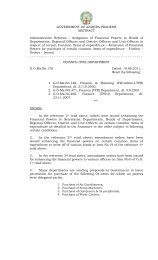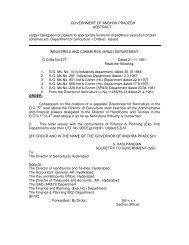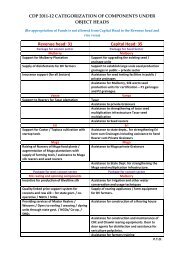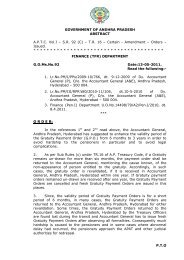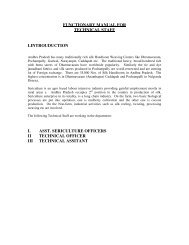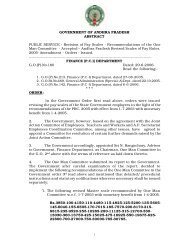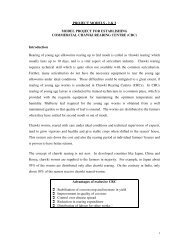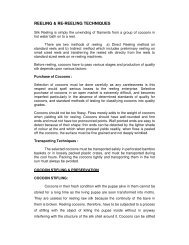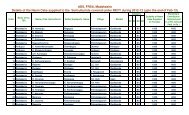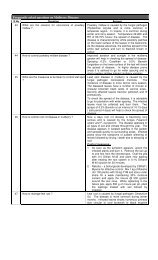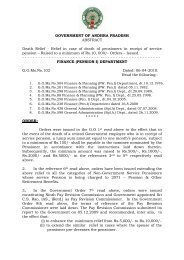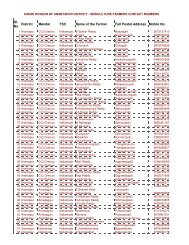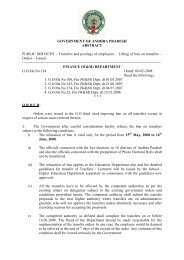Potentiality of eri culture for poverty alleviation in dry ... - Seri.ap.gov.in
Potentiality of eri culture for poverty alleviation in dry ... - Seri.ap.gov.in
Potentiality of eri culture for poverty alleviation in dry ... - Seri.ap.gov.in
You also want an ePaper? Increase the reach of your titles
YUMPU automatically turns print PDFs into web optimized ePapers that Google loves.
IntroductionIndia enjoys a unique dist<strong>in</strong>ction <strong>of</strong> be<strong>in</strong>g the only country <strong>in</strong> the world produc<strong>in</strong>g all varieties <strong>of</strong>natural silk viz., Mulberry, Tasar, oak Tasar, <strong>eri</strong> and Muga. Among the commercially exploitedsilkworms, <strong>eri</strong> silkworm is completely domesticated multivolt<strong>in</strong>e species under non-mulberry(Vanya Silk) sector that is reared throughout the year. The advent <strong>of</strong> <strong>eri</strong> <strong>culture</strong> <strong>in</strong> the country islost <strong>in</strong>to antiquity but the fact rema<strong>in</strong>s that it has close l<strong>in</strong>k with <strong>culture</strong> and tradition <strong>of</strong> people <strong>of</strong>North-east India with the rural folk does this <strong>culture</strong> primarily to meet the domestic demand <strong>of</strong>warm cloth<strong>in</strong>g besides treat<strong>in</strong>g the pupae as a delicacy. Apart from the North-east region, <strong>eri</strong><strong>culture</strong> is also practiced <strong>in</strong> the states <strong>of</strong> West Bengal, Bihar and Orissa (Krishna Rao, 2003). Be<strong>in</strong>gtermed as a ‘poor man’s silk’, <strong>eri</strong> <strong>culture</strong> has all the necessary wherewithals <strong>of</strong> a small scale cottageenterprise. In a world where silk is almost and always associated with luxury, s<strong>of</strong>tness andglamour, <strong>eri</strong> silk although may not fit <strong>in</strong>to the same group ow<strong>in</strong>g to its coarseness and mundaneproperties, it can be blended with other yarns impart<strong>in</strong>g a special texture and feel to the fabric.Consid<strong>eri</strong>ng its new potential as a substantial supplementary <strong>in</strong>come generat<strong>in</strong>g occupation and lowrisk <strong>poverty</strong> alleviat<strong>in</strong>g vocation <strong>in</strong> rural and semi rural areas, <strong>eri</strong> <strong>culture</strong> has spread to differentparts <strong>of</strong> India <strong>in</strong>clud<strong>in</strong>g the state <strong>of</strong> Andhra Pradesh. Andhra Pradesh is one <strong>of</strong> the fast emerg<strong>in</strong>gstates <strong>in</strong> the southern zone <strong>in</strong> the country produc<strong>in</strong>g both mulberry and non-mulberry silks such asTasar and Eri on commercial scale and Muga on exp<strong>eri</strong>mental basis (Jay<strong>ap</strong>rakash, 2005). Dur<strong>in</strong>gthe year 2004-05, the state has produced 5,084 tons <strong>of</strong> mulberry silk, 16 tons <strong>of</strong> tasar silk and 10tons <strong>of</strong> <strong>eri</strong> silk.Eri silkworm, Samia cynthia ric<strong>in</strong>i, Boisd is polyphagous <strong>in</strong> nature and feed primarily on Castor((Ric<strong>in</strong>us communis) and t<strong>ap</strong>ioca (Manihot utilissima) that <strong>for</strong>m the secondary food plant.Castor (Ric<strong>in</strong>us communis), the primary food plant <strong>of</strong> <strong>eri</strong> silkworm (Samia Cynthia ric<strong>in</strong>i) iscultivated abundantly <strong>in</strong> the state <strong>of</strong> Andhra Pradesh that ranks second to Gujarat with 3.5 lakhhectares. An estimated 85% <strong>of</strong> castor is cultivated <strong>in</strong> the drought prone districts <strong>of</strong> Mahabubnagarand Nalgonda <strong>for</strong> oil seed and the leaf has no utility as it cannot be used as fodder. As cultivation <strong>of</strong>castor as oil seed crop become more popular, the <strong>eri</strong> silkworm <strong>culture</strong> utiliz<strong>in</strong>g the castor leaf to alarger extent rema<strong>in</strong>ed unorganized. Castor plants grow as shrubs or small trees <strong>in</strong> tropical andtemperate regions f<strong>in</strong>ds a place <strong>of</strong> importance <strong>in</strong> the cropp<strong>in</strong>g systems <strong>of</strong> <strong>dry</strong> land farm<strong>in</strong>g <strong>in</strong> semiaridzones.T<strong>ap</strong>ioca (Manihot utilissima, Pohl) popularly known as ‘Cassava’ is one <strong>of</strong> the secondary foodplant <strong>of</strong> <strong>eri</strong> silkworm. The crop has ga<strong>in</strong>ed importance as a che<strong>ap</strong> source <strong>of</strong> carbohydrates, ma<strong>in</strong>ly<strong>for</strong> human consumption through its tubers. T<strong>ap</strong>ioca, locally known as ‘karra pendalam’ or ‘sagodumpa’ is widely be<strong>in</strong>g cultivated <strong>for</strong> commercial purpose <strong>in</strong> the coastal areas <strong>of</strong> Andhra Pradesh.Prior to its popularization as <strong>in</strong>dustrial crop <strong>in</strong> Andhra Pradesh, it was cultivated as food crop by
the tribes <strong>of</strong> Rampachodavaram division <strong>of</strong> East Godavari District. Presently, around an area <strong>of</strong>25,000 hectares is under t<strong>ap</strong>ioca cultivation mostly as <strong>in</strong>ter crop that constitutes around 9%<strong>of</strong> thetotal area <strong>of</strong> t<strong>ap</strong>ioca <strong>in</strong> India. In East Godavari District, it is cultivated <strong>in</strong> <strong>dry</strong> and sandy patches asmono crop. Dur<strong>in</strong>g the year 2005-06, a total <strong>of</strong> 250081 dfls were reared cov<strong>eri</strong>ng 1222 farmers andharvested a quantity <strong>of</strong> 49527 kg <strong>of</strong> cocoons and realized an amount <strong>of</strong> Rs.25.86 lakhs.Utilization <strong>of</strong> about 30 to 40% <strong>of</strong> leaves from Castor and T<strong>ap</strong>ioca plantations <strong>for</strong> <strong>eri</strong> <strong>culture</strong> withouteffect<strong>in</strong>g the seed/tuber production respectively fetch the farmers substantial additional <strong>in</strong>come<strong>ap</strong>art from the regular earn<strong>in</strong>gs to the poor <strong>dry</strong> land cultivators besides provid<strong>in</strong>g ga<strong>in</strong>fulemployment to the women. It is established that about 25% <strong>of</strong> leaf pluck<strong>in</strong>g <strong>in</strong> T<strong>ap</strong>ioca would notaffect the normal tuber yield (Bhat et al., 1991). In the present study, the cocoon yield, potential,<strong>in</strong>come to the farmers and comparative economics <strong>of</strong> <strong>eri</strong> <strong>culture</strong> with the major <strong>dry</strong> land crops andits potentiality <strong>for</strong> <strong>poverty</strong> <strong>alleviation</strong> are discussed.Mat<strong>eri</strong>als and MethodsThe Eri <strong>culture</strong> areas <strong>in</strong> the state are broadly classified <strong>in</strong> to two zones based on the food plantsutilized <strong>for</strong> <strong>eri</strong> silkworm rear<strong>in</strong>g. The zone one, where castor is abundantly used <strong>for</strong> <strong>eri</strong><strong>culture</strong>comprised <strong>of</strong> Mahbubnagar, Nalgonda, Medak and Rangareddi districts. The zone two consists <strong>of</strong>East Godavari district, where T<strong>ap</strong>ioca is cultivated abundantly.Data CollectionDistrict wise data on 484 sample farmers (East Godavari-194, Mehbubnagar-163, Nalgonda-47 andRangareddi-21 farmers) <strong>for</strong> cocoon yield and <strong>in</strong>come generation <strong>of</strong> <strong>eri</strong> crops were collected. Thedata perta<strong>in</strong><strong>in</strong>g to <strong>in</strong>come with regard to <strong>eri</strong> <strong>culture</strong> and also major competitive <strong>dry</strong> land crops suchas maize, red gram, green gram and jowar were collected. The collected data were perta<strong>in</strong>ed to theyear 2005-06.Data AnalysisThe data collected were tabulated and analyzed through simple tabular analysis to estimate cocoonproductivity and pr<strong>of</strong>itability. The yield and economic potentiality <strong>of</strong> <strong>eri</strong> <strong>culture</strong> through elitefarmers (51 numbers) possess<strong>in</strong>g all the requisite facilities and technical know how <strong>of</strong> <strong>eri</strong> <strong>culture</strong>was also analyzed separately. For the same coefficient <strong>of</strong> variation was computed to assess theextent <strong>of</strong> variability. Usual Student-t test was used <strong>for</strong> comparison <strong>of</strong> means and to check thesignificance <strong>of</strong> difference <strong>in</strong> means <strong>for</strong> productivity. The comparative economics <strong>of</strong> <strong>eri</strong> <strong>culture</strong> vis avis <strong>dry</strong> land crops was also worked out.
ResultsZone-I (Castor area):In Andhra Pradesh, Castor, the primary food <strong>for</strong> <strong>eri</strong> silkworms is ma<strong>in</strong>ly cultivated <strong>in</strong> the droughtprone districts <strong>of</strong> Mahabubnagar, Nalgonda, Rangareddy and Medak districts under ra<strong>in</strong> fedconditions (<strong>dry</strong> land areas <strong>in</strong> semi arid zones). It is well established that about 30 – 40% <strong>of</strong> leafutilization from castor <strong>for</strong> <strong>eri</strong> <strong>culture</strong> may not effect the castor seed production. The productivityand <strong>in</strong>come from <strong>eri</strong> <strong>in</strong> the above districts is analyzed as here under.Mahbubnagar: The yield and <strong>in</strong>come from <strong>eri</strong> <strong>culture</strong> <strong>in</strong> the district is analyzed with 163 farmers.The data suggest that the cocoon productivity was <strong>in</strong> the range <strong>of</strong> 20.0 kg to 88.7 kg per 100 dflswith an average yield <strong>of</strong> 33.8 kg. Correspond<strong>in</strong>gly, the amount realized varied from Rs.1002/- toRs.4435/- with an average <strong>in</strong>come <strong>of</strong> Rs.1690/- per 100 dfls.Nalgonda: The cocoon yield and <strong>in</strong>come generated from <strong>eri</strong> <strong>culture</strong> is analyzed with 47 farmers.The data suggest that the cocoon productivity varied from a m<strong>in</strong>imum <strong>of</strong> 20.1 kg to a maximum <strong>of</strong>54.2 kg with an average <strong>of</strong> 31.9 kg per 100 dfls. Majority <strong>of</strong> the farmers (33) reared about 100 dflsper crop. The m<strong>in</strong>imum <strong>in</strong>come from the rear<strong>in</strong>g <strong>of</strong> 100 dfls was Rs.1007/- to a maximum <strong>of</strong>Rs.2710/- with an average <strong>in</strong>come <strong>of</strong> Rs.1597/-.Medak: The cocoon yield and <strong>in</strong>come generated from <strong>eri</strong> <strong>culture</strong> is analyzed with 59 farmers fromthe district. Most <strong>of</strong> the farmers (34) have reared about 100 dfls at a time. The data present that onan average, 33.3 kg <strong>of</strong> cocoon yield per 100 dfls is obta<strong>in</strong>ed rang<strong>in</strong>g from 20.9 kg to 55.1 kg. Them<strong>in</strong>imum <strong>in</strong>come from the rear<strong>in</strong>g <strong>of</strong> 100 dfls was Rs.1047/- to a maximum <strong>of</strong> Rs.2754/- with anaverage <strong>of</strong> Rs.1665/-.Rangareddi: Data on the cocoon yield and <strong>in</strong>come levels is analyzed with 21 farmers <strong>in</strong> thedistrict. The cocoon yield <strong>in</strong> the district ranged from a m<strong>in</strong>imum <strong>of</strong> 20.1 kg to a maximum <strong>of</strong> 44.6kg per 100 dfls reared with an average yield <strong>of</strong> 27.8 kg. The <strong>in</strong>come generated from the rear<strong>in</strong>g <strong>of</strong>100 dfls was <strong>in</strong> the range <strong>of</strong> Rs.1006/- to Rs.2230/- with an average <strong>of</strong> Rs.1390/-. The data ispresented <strong>in</strong> Table-1.The mean productivity between the four districts was compared and the results (Table-2) revealedthat the cocoon productivity level <strong>in</strong> the Rangareddy District is significantly lower (P
plantation without effect<strong>in</strong>g tuber yield and <strong>eri</strong> farmers use this excess <strong>of</strong> leaf <strong>for</strong> <strong>eri</strong> <strong>culture</strong> andearn additional <strong>in</strong>come. The analysis <strong>of</strong> <strong>eri</strong> rear<strong>in</strong>g per<strong>for</strong>mance <strong>of</strong> 194 farmers <strong>in</strong> the districtsuggests that average productivity is 34.8 kg per 100 dfls with a maximum <strong>of</strong> 77.0 kg andm<strong>in</strong>imum <strong>of</strong> 20.3 kg. The <strong>in</strong>come from the rear<strong>in</strong>g <strong>of</strong> 100 dfls varied from a m<strong>in</strong>imum <strong>of</strong> Rs.1017/-to a maximum <strong>of</strong> Rs.3850/- with an average <strong>of</strong> Rs.1750/- <strong>for</strong> 100 dfls. The data is presented <strong>in</strong>Table-1.Improvement <strong>of</strong> yield and <strong>in</strong>come <strong>of</strong> progressive farmers:Further, the <strong>eri</strong> crop per<strong>for</strong>mance and <strong>in</strong>come obta<strong>in</strong>ed by the progressive farmers irrespective <strong>of</strong>food plants (51 farmers), who are hav<strong>in</strong>g all the facilities, technical competence <strong>for</strong> conduct<strong>in</strong>g the<strong>eri</strong> rear<strong>in</strong>g was analyzed district wise (Table 3). The data depicts that the average cocoonproductivity per 100 dfls was 55.6 kg. On an average the <strong>in</strong>come obta<strong>in</strong>ed from rear<strong>in</strong>g <strong>of</strong> 100 dflswas Rs.2780/-.Comparative yield per<strong>for</strong>mance - Castor vs T<strong>ap</strong>ioca:The comparison <strong>of</strong> the cocoon productivity <strong>of</strong> the <strong>eri</strong> farmers between the two zones under study(T<strong>ap</strong>ioca – 34.77 kg) and (Castor – 32.94 kg) suggest that there is no significant difference(P>0.05) <strong>in</strong> the cocoon productivity between the two food plants, although there is an <strong>in</strong>crease yield<strong>of</strong> about 2 kg from the rear<strong>in</strong>g <strong>of</strong> 100 dfls on t<strong>ap</strong>ioca (Table 4).Comparison with other <strong>dry</strong> cropsThe yield and <strong>in</strong>come (per hectare per year) from <strong>eri</strong> <strong>culture</strong> with competitive <strong>dry</strong> land crops <strong>in</strong>Zone-1 and Zone-2 <strong>of</strong> the state is presented <strong>in</strong> Figure-1 and Table 5. A perusal <strong>of</strong> the data revealsthat <strong>in</strong> Zone-I, the net returns from <strong>dry</strong> land crops varied from a m<strong>in</strong>imum <strong>of</strong> Rs.1500/- (Jowar) to ahigh <strong>of</strong> Rs.5500/- (Red gram), where as an <strong>in</strong>come <strong>of</strong> Rs.3500/- is obta<strong>in</strong>ed from castor alone. Anadditional net <strong>in</strong>come <strong>of</strong> Rs.4000/- is obta<strong>in</strong>ed from <strong>eri</strong> <strong>culture</strong>. Thus a total net <strong>in</strong>come <strong>of</strong>Rs.7500/- can be realized from castor coupled with <strong>eri</strong> <strong>culture</strong>. In Zone-II, a maximum net <strong>in</strong>come<strong>of</strong> Rs.6200/- can be realized from maize, whereas t<strong>ap</strong>ioca cultivation fetches a net <strong>in</strong>come <strong>of</strong>Rs.6875/-. Eri <strong>culture</strong> on t<strong>ap</strong>ioca provides an additional <strong>in</strong>come <strong>of</strong> Rs.4000/-. Thus, the total netreturns <strong>of</strong> Rs.10875/- can be earned from t<strong>ap</strong>ioca with <strong>eri</strong> <strong>culture</strong>.DiscussionEri <strong>culture</strong> is proved to be an ideal subsidiary occupation <strong>in</strong> India provid<strong>in</strong>g ga<strong>in</strong>ful supplementary<strong>in</strong>come to a large number <strong>of</strong> rural and tribal populations as the occupation depends on lessexpensive <strong>dry</strong> land plantations like Castor and T<strong>ap</strong>ioca utiliz<strong>in</strong>g only the excess leaf to an extent <strong>of</strong>30 – 40% without effect<strong>in</strong>g the seed /tuber production. Although prospects <strong>of</strong> <strong>eri</strong> <strong>culture</strong> <strong>in</strong> northeastern India are proved beyond doubt as it goes with local tradition and way <strong>of</strong> life, <strong>of</strong> late itsspread to southern parts <strong>of</strong> India is ga<strong>in</strong><strong>in</strong>g momentum with the <strong>in</strong>creased cultivation <strong>dry</strong> land and
up land crops like Castor and T<strong>ap</strong>ioca and Andhra Pradesh is one among the states where dueemphasis is be<strong>in</strong>g given <strong>for</strong> its promotion.The geo-eco climatic conditions <strong>of</strong> Andhra Pradesh favour commercial production <strong>of</strong> all thevarieties <strong>of</strong> natural silks <strong>of</strong> which <strong>eri</strong> <strong>culture</strong> is be<strong>in</strong>g given due thrust to supplement the <strong>in</strong>come <strong>of</strong>Castor and T<strong>ap</strong>ioca growers through better utilization <strong>of</strong> leaves without effect<strong>in</strong>g the seed/tuberproduction. In addition, adoption <strong>of</strong> <strong>eri</strong> <strong>culture</strong> provides additional employment <strong>for</strong> tribals andother poor rural populace and contributes to the <strong>in</strong>creased productivity <strong>of</strong> <strong>eri</strong> silk <strong>in</strong> the country(Jay<strong>ap</strong>rakash et. al.., 2005).Eri silkworm, Philosamia ric<strong>in</strong>i be<strong>in</strong>g polyphagous <strong>in</strong> nature feed primarily on Castor (Ric<strong>in</strong>uscommunis) which is one <strong>of</strong> the major <strong>dry</strong> land crops <strong>in</strong> Zone-I compris<strong>in</strong>g the districts <strong>of</strong>Mahabubnagar, Nalgonda, Medak and Rangareddy districts <strong>in</strong> Telangana region and T<strong>ap</strong>ioca(Manihot utilissima) that is grown up land areas under ra<strong>in</strong> fed conditions <strong>in</strong> Zone-II cov<strong>eri</strong>ng EastGodavari District <strong>in</strong> coastal Andhra Pradesh. Apart from North-East, regular cultivation <strong>of</strong> Castoris done only <strong>for</strong> the production <strong>of</strong> oil seeds while T<strong>ap</strong>ioca <strong>for</strong> tuber production. It is wellestablished that 30 – 40% <strong>of</strong> foliage from castor/T<strong>ap</strong>ioca plantation can be used <strong>for</strong> <strong>eri</strong> silkwormrear<strong>in</strong>g without effect<strong>in</strong>g the seed/tuber production (Jay<strong>ap</strong>rakash et al., 2003). It is <strong>in</strong> this context,<strong>eri</strong> <strong>culture</strong> is provid<strong>in</strong>g substantial additional <strong>in</strong>come <strong>ap</strong>art from the regular earn<strong>in</strong>gs to the poor <strong>dry</strong>land cultivators besides provid<strong>in</strong>g ga<strong>in</strong>ful employment to the women <strong>in</strong> both the Zones under study.The potentiality <strong>of</strong> <strong>eri</strong> <strong>culture</strong> as a viable subsidiary avocation has been highlighted by manyworkers (Jay<strong>ap</strong>rakash et al., 2003; Sartchandra, 2003; Prakash et al., 2003 and Rama Rao et al.,2005) both with Castor and T<strong>ap</strong>ioca. In the present <strong>in</strong>vestigation, analysis <strong>of</strong> the productivitylevels and <strong>in</strong>come obta<strong>in</strong>ed through <strong>eri</strong> <strong>culture</strong> utiliz<strong>in</strong>g the foliage from Castor and T<strong>ap</strong>ioc<strong>ap</strong>lantations revealed that there is no significant differences <strong>in</strong> the yield levels and <strong>in</strong>comesuggest<strong>in</strong>g that both food plants provide adequate additional <strong>in</strong>come from <strong>eri</strong> <strong>culture</strong>. Successfulattempts have been made to improve further the earn<strong>in</strong>gs <strong>of</strong> castor growers without affect<strong>in</strong>g thecastor seed yield by adopt<strong>in</strong>g the <strong>eri</strong> <strong>culture</strong> especially through active participation <strong>of</strong> women folk<strong>in</strong> the rural areas where <strong>poverty</strong> and unemployment is on higher side.The production cost <strong>of</strong> Castor was observed less among the big farm<strong>in</strong>g category followed by smalland marg<strong>in</strong>al farmers. The <strong>eri</strong> cocoon yield utiliz<strong>in</strong>g the foliage <strong>of</strong> Castor among the farmers <strong>of</strong> the4 districts studied except <strong>for</strong> Rangareddy suggested no significant differences between them as thefarmers are well exp<strong>eri</strong>enced with the practices <strong>for</strong> <strong>eri</strong> <strong>culture</strong>. However, the low productivityrecorded by the farmers from Rangareddy district may be attributed to the fact that <strong>eri</strong> <strong>culture</strong> isrelatively new and the farmers are not hav<strong>in</strong>g adequate exp<strong>eri</strong>ence and technical know-howcompared to others.
Eri <strong>culture</strong> is also be<strong>in</strong>g practiced with the foliage <strong>of</strong> T<strong>ap</strong>ioca, the tuber crop. It is proved that theleaf pluck<strong>in</strong>g dur<strong>in</strong>g 3 to 4, 4 to 5 and 8 to 9 months does not significantly affect the yield <strong>of</strong> Castorseed/T<strong>ap</strong>ioca tuber (Jay<strong>ap</strong>rakash et al., 2003). It is also established that about 5000 to 6000 kg <strong>of</strong>leaf is available <strong>for</strong> harvest per hectare <strong>of</strong> T<strong>ap</strong>ioca plantation which is quite substantial <strong>for</strong>conduct<strong>in</strong>g <strong>eri</strong> rear<strong>in</strong>g without affect<strong>in</strong>g the yield <strong>of</strong> tuber. The study confirmed the highercomb<strong>in</strong>ed <strong>in</strong>come (Rs.10,875/-) from <strong>eri</strong> <strong>culture</strong> with T<strong>ap</strong>ioca.By cultivat<strong>in</strong>g the Castor alone as ma<strong>in</strong> crop the farmer can earn an average <strong>in</strong>come <strong>of</strong> aboutRs.3500/ha/year. The rear<strong>in</strong>g <strong>of</strong> <strong>eri</strong> from the same plantation will fetch another Rs.4000/- asadditional <strong>in</strong>come to the farmer. Hence, the comb<strong>in</strong>ed <strong>in</strong>come <strong>of</strong> Castor and <strong>eri</strong> <strong>culture</strong> amount toRs.7500/ ha/year. It is observed that the <strong>in</strong>come obta<strong>in</strong>ed from rear<strong>in</strong>g <strong>eri</strong> silkworms and Castorwithout affect<strong>in</strong>g the seed yield is more than the harvest <strong>of</strong> Castor seed alone. Similarly, thecultivation <strong>of</strong> T<strong>ap</strong>ioca only <strong>for</strong> the tuber production will provide an <strong>in</strong>come <strong>of</strong> Rs.6875/ha/year,whereas the rear<strong>in</strong>g <strong>of</strong> <strong>eri</strong> silkworms provides additional <strong>in</strong>come <strong>of</strong> Rs.4000/- result<strong>in</strong>g <strong>in</strong> acomb<strong>in</strong>ed revenue <strong>of</strong> Rs.10875/-.Further the analysis <strong>of</strong> data on the comparative yield per<strong>for</strong>mance <strong>of</strong> <strong>eri</strong> cocoons obta<strong>in</strong>ed utiliz<strong>in</strong>gthe leaf from Castor and T<strong>ap</strong>ioca plantations revealed that the rear<strong>in</strong>g per<strong>for</strong>mance <strong>of</strong> T<strong>ap</strong>iocaleaves is on par with castor. In fact, T<strong>ap</strong>ioca exhibited better per<strong>for</strong>mance yield<strong>in</strong>g about 2 kg morecocoons than the Castor <strong>for</strong> 100 dfls reared, though it is not significant statistically. From this it isestablished that T<strong>ap</strong>ioca can also effectively be utilized <strong>for</strong> better productivity though it isconsidered as a secondary food plant <strong>for</strong> <strong>eri</strong> silkworms.The potentiality <strong>of</strong> <strong>eri</strong> <strong>culture</strong> as an additional <strong>in</strong>come resource is well established with progressivefarmers. The cocoon productivity and <strong>in</strong>come were comparatively higher than the overall farmers.There was an <strong>in</strong>crease <strong>of</strong> 21.6 kg <strong>of</strong> cocoons <strong>for</strong> every 100 dfls with an enhanced <strong>in</strong>come <strong>of</strong>Rs.1162/-. In percentage terms <strong>in</strong>crease <strong>in</strong> cocoon productivity and <strong>in</strong>come registered 64% and71.8% respectively. This is attributed to adequate <strong>in</strong>frastructure facilities, technical know how andproper management skills <strong>of</strong> the progressive farmers. It is reported (Jay<strong>ap</strong>rakash et al., 2005) thatnet <strong>in</strong>come <strong>in</strong>creases from three to five times over cost <strong>of</strong> production <strong>of</strong> castor seed and <strong>eri</strong> cocoonwhich is attributed to <strong>in</strong>volvement <strong>of</strong> less <strong>in</strong>puts and low risks <strong>in</strong> <strong>dry</strong> land castor cultivationsuggest<strong>in</strong>g the higher potential <strong>for</strong> <strong>eri</strong> <strong>culture</strong> <strong>in</strong> the state. It is also established by Jay<strong>ap</strong>rakash etal., (2005) that the women participation <strong>in</strong> <strong>eri</strong> silkworm rear<strong>in</strong>g, particularly <strong>in</strong> leaf harvest<strong>in</strong>g,feed<strong>in</strong>g and clean<strong>in</strong>g activities was more <strong>in</strong> comparison to men who have major role <strong>in</strong> pre rear<strong>in</strong>gand market<strong>in</strong>g <strong>of</strong> cocoons.The major cash crops pos<strong>in</strong>g competition <strong>for</strong> <strong>eri</strong> <strong>culture</strong> are red gram, green gram and maize <strong>in</strong>Zone-I and maize <strong>in</strong> Zone-2. Hence, the economics <strong>of</strong> <strong>eri</strong> <strong>culture</strong>, red gram, green gram and maize
were worked out and compared. It is established from the results that among the four cropscompared, the comb<strong>in</strong>ed <strong>in</strong>come generated from Castor and <strong>eri</strong> <strong>culture</strong>, T<strong>ap</strong>ioca and <strong>eri</strong> <strong>culture</strong> wasfound to be more than the other crops <strong>in</strong> both the zones.There<strong>for</strong>e, it is evident from the study that the <strong>eri</strong> <strong>culture</strong> enterprise provides an ample opportunity<strong>for</strong> susta<strong>in</strong>able <strong>dry</strong> land based farm<strong>in</strong>g system <strong>for</strong> higher <strong>in</strong>come generation. The most importantfact is that <strong>eri</strong> <strong>culture</strong> goes well with <strong>dry</strong> land farmers, especially with tribals. On an average, threecrops were taken as aga<strong>in</strong>st the s<strong>in</strong>gle harvest <strong>in</strong> other <strong>dry</strong> land crops. The three crops <strong>in</strong> a yearwould be sufficient to ma<strong>in</strong>ta<strong>in</strong> a family through additional <strong>in</strong>come at a substantial level. It has awider scope <strong>for</strong> augment<strong>in</strong>g the family <strong>in</strong>come and employment opportunities.It was noticed that by practic<strong>in</strong>g <strong>eri</strong> <strong>culture</strong> there was a substantial <strong>in</strong>crease <strong>in</strong> annual <strong>in</strong>come <strong>of</strong> thefarmers which brought the total change <strong>in</strong> their assets and improvement <strong>in</strong> their livelihood. Hence,it played an important role <strong>in</strong> <strong>poverty</strong> <strong>alleviation</strong> and elim<strong>in</strong>ation <strong>of</strong> hunger to a considerable extent<strong>in</strong> <strong>dry</strong> land farmers.Consid<strong>eri</strong>ng the advantages <strong>of</strong> <strong>eri</strong> <strong>culture</strong> <strong>in</strong> the state, the Government has <strong>in</strong>itiated various steps topopularize <strong>eri</strong> <strong>culture</strong> <strong>in</strong> the state and also to stabilize this cottage <strong>in</strong>dustry through variousmeasures such as production <strong>of</strong> commercial <strong>eri</strong> seed with<strong>in</strong> the organized Seed Farms, impart<strong>in</strong>gnecessary tra<strong>in</strong><strong>in</strong>g <strong>in</strong> <strong>eri</strong> <strong>culture</strong> technologies, conduct<strong>in</strong>g field visits and exposure visits besidesestablish<strong>in</strong>g Eri sp<strong>in</strong>n<strong>in</strong>g mill under corporate sector with a consumption c<strong>ap</strong>acity around 70tonnes/annum to create market<strong>in</strong>g facilities to the farmers etc.ReferencesBhat , G.G.; T. Umesh and Naik Ramakrishna (1991) T<strong>ap</strong>ioca is an ideal root upon which to rearthe <strong>eri</strong> silkworm. Indian Silk, April, 1991: 19 – 20.Jaya Prakash, P.; B.V.S. Rao, K. Venkateshwar Rao, J.V. Krishna Rao and B.R.R.P. S<strong>in</strong>ha(2003). Re<strong>in</strong>troduction <strong>of</strong> <strong>eri</strong> <strong>culture</strong> <strong>in</strong> Andhra Pradesh: Hopes galore. Indian Silk, April,2003. 19 – 20.Jay<strong>ap</strong>rakash, P.; A. Sasikala and N. Suryanarayana (2005) Eri<strong>culture</strong>- A tool <strong>for</strong> rural womendevelopment <strong>in</strong> Andhra Pradesh, India. Conference P<strong>ap</strong>ers (3.18) In: The 20 th Congress <strong>of</strong> theInternational S<strong>eri</strong>cultural Commission, Bangalore. 106 – 109.Krishna Rao, J.V. (2003) Large scale development <strong>of</strong> Eri<strong>culture</strong> <strong>in</strong> India. Indian Silk, 42(1):27 –29.Prakash K.S., R.N. Prasad; C.V.N. Ravikishore; M. Rama Rao; J.V. Krishna Rao and R.P.Khanna (2003) Eri <strong>culture</strong> – An additional source <strong>of</strong> <strong>in</strong>come <strong>for</strong> t<strong>ap</strong>ioca farmers. Indian Silk,41(12): 29 - 30Rama Rao, M.; R.N. Prasad and N. Suryanarayana (2005) Eri<strong>culture</strong> – An additional <strong>in</strong>come <strong>for</strong>t<strong>ap</strong>ioca (Cassava) growers and a good nourishment to the mal-nutritioned tribal populace.Conference P<strong>ap</strong>ers (3.16) In: The 20 th Congress <strong>of</strong> the International S<strong>eri</strong>cultural Commission,Bangalore 94-98.Saratchandra, B. (2003). A thought <strong>for</strong> development <strong>of</strong> <strong>eri</strong> <strong>culture</strong> <strong>in</strong> India. Indian Silk April,2003. 25 – 28.
DistrictTable 1. Production pr<strong>of</strong>ile <strong>of</strong> <strong>eri</strong> <strong>culture</strong> <strong>in</strong> Andhra Pradesh (2005 -2006)No. <strong>of</strong>farmersNo. <strong>of</strong> dflsrearedTotal Yeild(kg)Productivity/100 dflsAverageIncome/100 dfls(Rs.)Max. M<strong>in</strong>. Avg. Max. M<strong>in</strong>. Avg. Max. M<strong>in</strong>. Avg. Max. M<strong>in</strong>. Avg.Zone-IMaha- 163 300 5 103 96.2 1.6 34.5 88.7 20.0 33.8 4435 1002 1690bubnagarNalgo- 47 150 50 91 65.0 11.7 28.9 54.2 20.1 31.9 2710 1007 1597ndaMedak 59 400 25 136 128.7 7.46 44.4 55.1 20.9 33.3 2754 1047 1665Ranga- 21 200 50 105 49.8 15.1 28.8 44.6 20.1 27.8 2230 1006 1390ReddyZone-IIEastGodavari194 1200 50 211 445.5 12.0 70.2 77.0 20.3 34.8 3850 1017 1750DistrictEast GodavariMahabubnagarTable 2. District wise comparative yield per<strong>for</strong>manceCocoonyield/100 dfls(Kg)Comparisonwith otherDistrictsCocoonyield/100 dfls (Kg)34.8 Mehabubnagar 33.8 NSNalgonda 31.9 NSMedak 33.3 NSRangareddy 27.8 *33.8 Nalgonda 31.9 NSMedak 33.3 NSRangareddy 27. 8 *31.9 Medak 33.3 NSNalgondaRangareddy 27.8 *Medak 33.3 Rangareddy 27.8 *** Significant at P
Table 3. Cocoon yield and <strong>in</strong>come details <strong>of</strong> progressive farmersDistrictNo. <strong>of</strong>farmersProductivity/100 dfls (kg)Income/100dfls(Rs.)Average S.D. CV% AverageEast Godavari 24 55.4 7.58 13.7 2770Mehaboobnagar 16 59.0 10.0 17.1 2950Medak 5 51.0 3.0 5.0 2550Nalgonda 6 50.3 2.4 4.7 2515Total 51 55.6 8.23 14.8 2780Table 4. Comparative yield per<strong>for</strong>mance between two food plants(T<strong>ap</strong>ioca vs Castor)Source <strong>of</strong> variation df MSS F ratioBetween groups 1 388.14 3.485 (NS)With <strong>in</strong> groups 482 111.54 (P
1200010000Income (Rs)80006000400020000RedgramMaizeJowarCastorT<strong>ap</strong>iocaEri & CastorEri & T<strong>ap</strong> !"""#$"%



